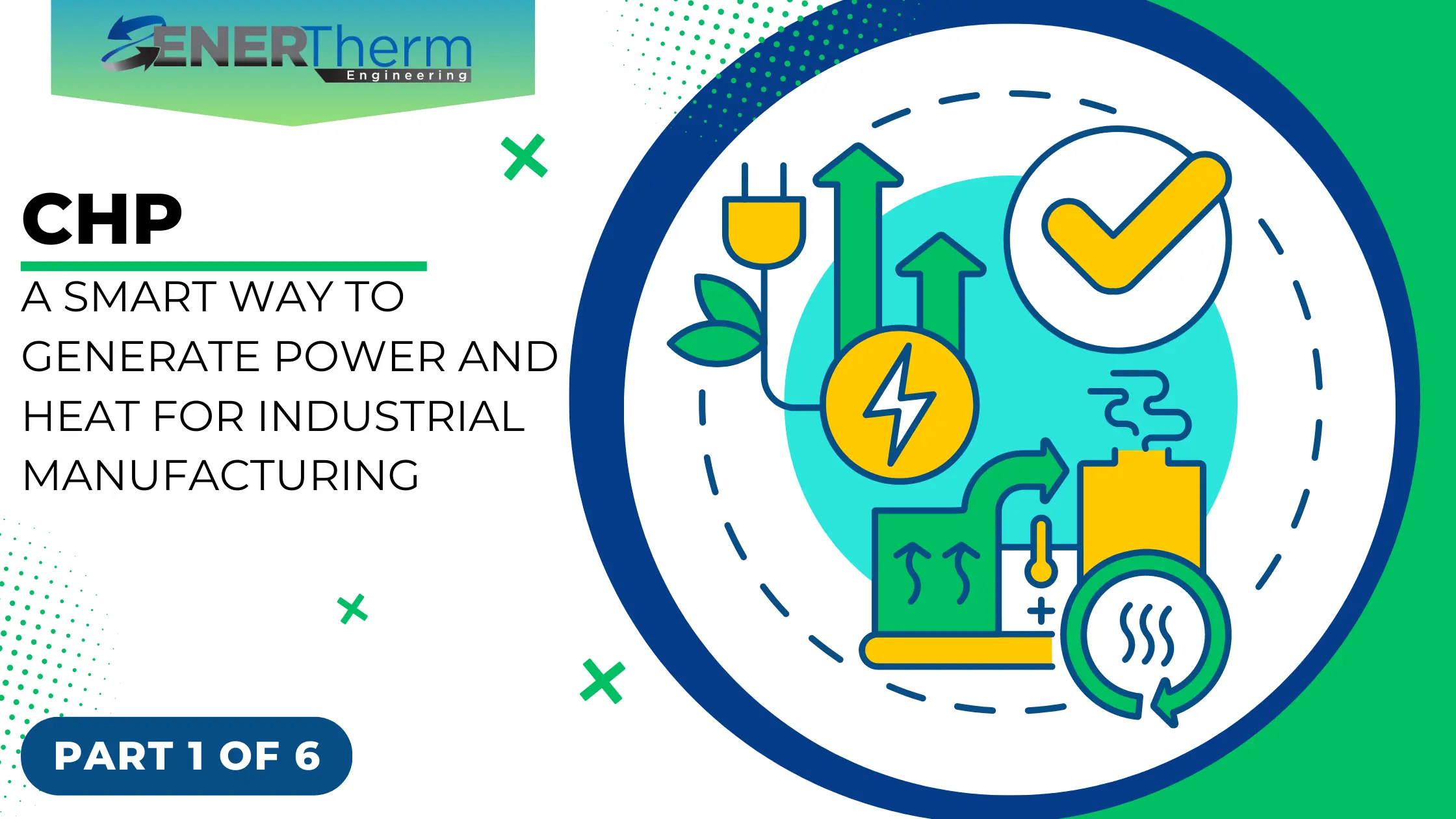What is CHP and what is it used for in industrial manufacturing?
CHP stands for combined heat and power. It is a system that generates both electricity and useful heat from a single fuel source, such as natural gas, biomass, or hydrogen. CHP can reduce emissions by avoiding the losses and inefficiencies of separate power generation and heat production.
CHP can be used for various purposes in industrial manufacturing, such as:
- Providing power and heat for industrial processes that require both electricity and steam or hot water, such as chemicals, metals, or paper. CHP can provide power and heat at different voltage and temperature levels, ranging from low (<1 kV and <100°C) to high (>10 kV and >400°C), depending on the type and design of the CHP system.
- Providing power and heat for industrial buildings that require both electricity and space heating or cooling, such as factories, warehouses, or workshops. CHP can provide power and heat at different voltage and temperature levels, ranging from low (<1 kV and <35°C) to high (>10 kV and >55°C), depending on the type and design of the CHP system.
- Providing power and heat for district networks that supply electricity and heat to multiple industrial users or buildings, such as industrial parks, campuses, or clusters. CHP can provide power and heat at different voltage and temperature levels, ranging from low (<1 kV and <35°C) to high (>10 kV and >55°C), depending on the type and design of the CHP system.
How efficient is CHP for industrial manufacturing?
The efficiency of CHP for industrial manufacturing depends on various factors, such as the type of CHP system (reciprocating engine, gas turbine, steam turbine, or fuel cell), the electrical efficiency, and the thermal efficiency.
The type of CHP system
The type of CHP system refers to the method of converting fuel energy into electricity and heat. The main types of CHP systems are:
- Reciprocating engine, which uses an internal combustion engine to drive an electric generator, and captures the waste heat from the engine exhaust and cooling systems.
- Gas turbine, which uses a gas turbine to drive an electric generator, and captures the waste heat from the turbine exhaust.
- Steam turbine, which uses a boiler to produce steam from the fuel combustion, and uses the steam to drive a steam turbine and an electric generator, and captures the waste heat from the steam condensation.
- Fuel cell, which uses an electrochemical device to convert the chemical energy of the fuel directly into electricity and heat.
The electrical efficiency
The electrical efficiency refers to the percentage of fuel energy that is converted into electricity by a CHP system. The electrical efficiency depends on various factors, such as the type and design of the CHP system, the fuel quality, and the operational conditions. The typical electrical efficiency for CHP systems ranges from 25% to 50% .
The thermal efficiency
The thermal efficiency refers to the percentage of fuel energy that is converted into useful heat by a CHP system. The thermal efficiency depends on various factors, such as the type and design of the CHP system, the heat demand, and the heat losses. The typical thermal efficiency for CHP systems ranges from 40% to 60% .
The overall efficiency of a CHP system is measured by its total efficiency, which is the sum of its electrical efficiency and its thermal efficiency. The higher the total efficiency, the more efficient the CHP system. The typical total efficiency for CHP systems ranges from 65% to 80% , which is much higher than the total efficiency of separate power generation (35%) and heat production (50%) .
What are the pros and cons of CHP for industrial manufacturing?
CHP has several advantages for industrial manufacturing, such as:
- Higher energy efficiency, which means that they can deliver more electricity and heat than separate systems, reducing energy costs and emissions.
- Lower fuel costs, which means that they can use cheaper and more abundant fuels than separate systems, such as natural gas, biomass, or hydrogen.
- Improved reliability, which means that they can provide uninterrupted and stable power and heat supply for industrial processes or buildings, even in case of grid failures or disruptions.
- Lower emissions, which means that they can reduce greenhouse gas emissions from industrial manufacturing, if using low-carbon fuels or renewable electricity grids.
However, CHP also has some disadvantages for industrial manufacturing, such as:
- High capital costs, which means that they have higher upfront and installation costs than separate systems, especially for retrofitting existing processes or buildings.
- Technical complexity, which means that they require careful planning and design, as well as skilled operators and contractors, to ensure optimal performance and reliability.
- Regulatory barriers, which means that they face challenges for obtaining permits, tariffs, and incentives for CHP projects, especially for the export or import of electricity or heat to or from the grid.
- Environmental impacts, which means that they have potential impacts on air quality, noise, and water use, if using fossil fuels or biomass.
How much can CHP contribute to net zero and decarbonisation goals for industrial manufacturing?
CHP can contribute significantly to net zero and decarbonisation goals for industrial manufacturing, by reducing the energy consumption and emissions from separate power generation and heat production. According to the International Energy Agency (IEA) , CHP could cut global CO2 emissions from industrial manufacturing by 1.7 gigatons per year by 2050, compared to a business-as-usual scenario. This would represent a 17% reduction in industrial emissions, and a 5% reduction in global emissions.
The potential contribution of CHP to net zero and decarbonisation goals for industrial manufacturing depends on various factors, such as the availability and cost of low-carbon electricity and fuels, the development and deployment of low-carbon industrial processes, the adoption and diffusion of CHP technologies, and the policy support and incentives for CHP projects.
According to the IEA , CHP could constitute approximately 20% of cumulative CO2 emissions reductions in industry by 2050, compared to a business-as-usual scenario. This would require a rapid increase in the deployment of CHP projects, from 150 megatons per year in 2020 to 600 megatons per year in 2030, and to 1,700 megatons per year in 2050. This would also require a significant increase in the installed capacity of CHP, from 150 megawatts in 2020 to 600 megawatts in 2030, and to 1,700 megawatts in 2050.
Are CHP future-proof for industrial manufacturing?
CHP is likely to be future proof for industrial manufacturing, as it can provide a low-carbon and cost-effective solution for generating power and heat. However, there are some challenges and uncertainties that need to be addressed, such as:
- Technological innovations, which are needed to improve the efficiency, performance, reliability, and durability of CHP technologies, as well as to reduce their costs, noise, and environmental impacts.
- Policy incentives, which are needed to create a favourable regulatory environment, provide financial support, remove market barriers, and raise awareness and confidence among industrial users and stakeholders.
- Market opportunities, which are needed to stimulate the demand and supply of power and heat from CHP projects, as well as to ensure their quality, safety, and sustainability.
- Fuel switching options, which are needed to enable the transition from fossil fuels or biomass to low-carbon fuels or renewable electricity grids.
To ensure that CHP is future proof for industrial manufacturing, it is important to foster collaboration and coordination among different actors, such as policy makers, industry associations, manufacturers, suppliers, researchers, and end-users. It is also important to monitor and evaluate the performance and impacts of CHP projects, and to share best practices and lessons learned. By doing so, CHP can play a key role in achieving net zero and decarbonisation goals for industrial manufacturing.
CHP in the Food Industry: A Closer Look
Let’s consider a large-scale brewery as an example:
Boiling and Pasteurization: In breweries, there is a need for high temperatures for processes such as boiling and pasteurization. By using a CHP system, a brewery can generate its own electricity for its production process. The waste heat from electricity generation can be harnessed to produce steam. This steam can then be used to boil the brew and pasteurize the beer, ensuring it is safe for consumption.
Refrigeration: After the beer has been brewed, it needs to be cooled and stored in refrigeration units. Some CHP systems have the added benefit of tri-generation, where the waste heat is used to generate chilled water for cooling purposes. In this scenario, the waste heat from the CHP system can be used to power absorption refrigerators, where a heat source is used to provide the energy needed to drive the cooling process.
Cleaning Processes: Breweries require significant cleaning to maintain hygiene standards. CHP systems can provide the necessary hot water and steam required for thorough cleaning and sterilization processes.
Carbon Emissions Reduction: Breweries are often under scrutiny for their environmental impact, particularly regarding their carbon emissions. Implementing a CHP system can significantly reduce a facility’s emissions by improving energy efficiency and reducing reliance on the grid. This not only results in cost savings but can also enhance a brewery’s reputation as an environmentally conscious brand.
This is just one example of CHP usage in the food industry. Other examples might include dairy production facilities, meat processing plants, or large-scale bakeries, all of which have significant heat and power needs.
Conclusion
In conclusion, the deployment of Combined Heat and Power (CHP) systems presents a transformative opportunity for the industrial sector. The potential for CHP systems to improve overall energy efficiency, decrease operational costs, and significantly reduce carbon emissions is immense, making it a viable and sustainable choice for energy generation.
CHP’s ability to provide simultaneous power and heat production from a single fuel source not only supports complex industrial processes but also boosts the efficient utilization of resources. The adaptability of CHP systems, as demonstrated through our examination of the food industry, highlights its extensive applicability and its potential in driving forward a diverse range of industries towards a greener, more sustainable future.
However, it’s also evident that to fully unlock the potential of CHP systems, concerted efforts from all stakeholders, including policy makers, manufacturers, and end-users, are required. Overcoming regulatory barriers, encouraging technological innovation, and creating market opportunities are critical to fostering a favourable environment for CHP adoption.
The path to industrial decarbonization and net-zero goals is not easy, but the versatility and efficiency of CHP systems make them a strong contender in this transition. As we move towards a future characterized by an increased emphasis on sustainability and energy efficiency, the role of CHP systems is poised to be pivotal. By embracing this technology, we can not only transform our industries but also contribute to a healthier and more sustainable planet.

